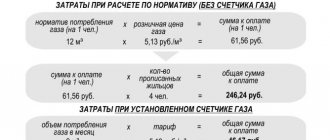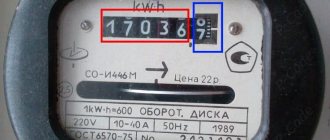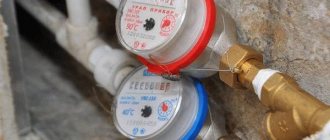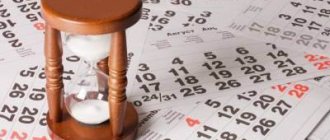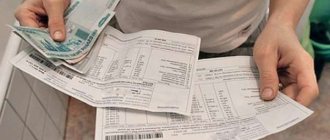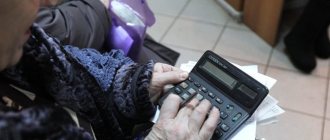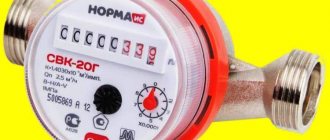How to pay for water by meter
How to pay for water by meter
If you are reading this article, then you most likely plan to install a water meter. This is beneficial, we have already talked about this. We only note that after installation, the water meter must also be registered. When all this is finished, the actual exploitation begins. And here the question arises: how to pay for water using the meter, where to go, and how is water consumption calculated in general?
Taking readings
Visually, you can see 8 scrolling numbers on the counters. On newly delivered sensors, only the last 2 digits (or 1) have non-zero values.
Each of the videos has its own color: red or black. The first color indicates those that read the number of liters and watts consumed. Black rollers display the cubic meters and kilowatts used.
Tariffs are calculated based on the amount per 1 cubic meter or 1 kilowatt, so in order to pay, it is important to take into account the black numbers.
- It follows from this that taking readings is a simple communication of the numbers already displayed. In this case, red ones are absolutely not taken into account.
- Thus, if the water meter shows “0000 6781”, this means that 6 cubic meters have been spent (rounded up to 7).
- This is the information that must be provided when paying.
When it comes to electricity, only kilowatts are important.
If the counter is lying
To check, the meter is dismantled and taken to the laboratory
If you notice that the meter is showing false information, you should check it. The verification will be carried out at your expense. If the meter is under warranty, then the certified company that sold it will pay. During this time, you will pay for water according to your average monthly consumption. After the inspection is completed, the water meter is repaired or replaced. If you overpaid, a recalculation occurs and the overpayment amount is returned to you.
Now about the cause of the malfunction. Your guilt is determined if the seal on the meter is damaged, the glass is broken, or the arrows are missing, if a scheduled check was not done. Then you will face a fine.
Addition
Provided that the apartment has more than one metering device (sewage, cold and hot water supply), readings should be taken from all of them.
The issued receipt will contain several fields; when calculating the amount, it will be necessary to provide all available readings.
How to take readings from three-phase meters
There are two types of three-phase electricity meters - the old type, which requires transformers, and electronic direct connection (without transformers). If an electronic one is installed, the electricity meter readings must be taken in the same way as described above. Simply write down the values, wait until the necessary information is displayed on the screen, or “scroll” the data to the required page.
Connecting an electric meter in a three-phase network via current transformers
If a large amount of power is allocated or an old-style meter is installed, a transformer is installed on each of the phases. To take readings in this case, you need to know the transformation ratio. The readings taken must be multiplied by this coefficient. The resulting figure will be the actual expense.
But in general, you need to read the contract. The calculation procedure must be prescribed there - in some organizations they write out readings, put down the transformer data or transformation ratio, and the actual calculations are made by the operator himself. So, if you have a 3-phase meter, check the form and procedure for calculations when installing and sealing the metering device and putting it into operation.
Transfer process
Payments for utility services are calculated after the readings are transferred to the management company or to the EIRC (unified information and settlement center). When reporting, in any case, you must indicate the exact address of residence or the personal account of the supplier.
You can find out the account number by finding the corresponding line in the documents (water supply agreement, receipt for payment of housing and communal services). Typically, current accounts are used in small towns. In cities, one address is enough.
In order to provide information to the Criminal Code, you should call the hotline or register on the company portal, and then enter the information in your personal account. There are three ways to transfer data to the EIRC:
- Call your local office and tell the dispatcher;
- Go to the center yourself, and then leave a note in a special journal;
- Send via mail (there will most likely be delays here, so you should take care of this in advance).
The simplest and most convenient method is to use registration on the single center website. It is better to submit information at the beginning of the month, since payment must be made by the 10th.
Blog
Photo source: https://www.pexels.com/
The reason for writing this article was not only the onset of summer, but also a question received from our client regarding the correct calculation of the amount of payment for the cold water supply utility service to the lucky owners of households (residential buildings and gardens in the private sector).
The question is how to charge for cold water during the irrigation season when using a land plot and outbuildings located on it (bathhouse) in two different situations:
- if the household is equipped with one individual cold water meter, which measures the entire volume of its consumption in the house, in the bathhouse and for irrigation, but this meter is out of order,
- if cold water meters are installed for the house, for irrigation, and for the bathhouse, but one of them is out of order.
In our opinion, to answer the question posed, you first need to understand the concepts used in Rules No. 354, in particular the concepts of “household ownership” and “individual metering device”.
In paragraph 2 of Rules No. 354, homeownership means a residential building (part of a residential building) and outbuildings (garage, bathhouse (sauna, swimming pool) adjacent to it and (or) separately standing on a common plot of land with the residential building (part of the residential building) , greenhouse (winter garden), premises for keeping livestock and poultry, other facilities).
According to the Department of Real Estate, set out in Letter of the Ministry of Economic Development of Russia dated 03/09/2016 N OG-D23-3023, home ownership should be considered as a complex that includes a land plot provided for the placement and operation of a residential building, a residential building and auxiliary buildings serving it.
Those. The concept of home ownership is broader than the concept of a residential building, and a residential building is included in the home ownership, along with other objects.
Please also note that the types of residential premises are listed in Part 1 of Art. 16 of the Housing Code of the Russian Federation and include the following: a residential building, part of a residential building; apartment, part of an apartment; room.
The given list of types of residential premises is closed and does not include homeownership.
In clause 2 of Rules No. 354, an individual metering device is understood as a measuring instrument (a set of measuring instruments and additional equipment) installed:
- for one residential or non-residential premises in an apartment building (with the exception of residential premises in a communal apartment),
- for a residential building
(part of a residential building)
or household,
if technically possible, and used to determine the volume (quantity) of consumption of a communal resource in each of the specified premises, residential building (part of a residential building) or household.
From the above provision it follows that accounting for the consumption of communal resources in relation to household ownership can be organized as follows:
- or the household is equipped with an IPU, which measures the volume of consumed utility resources in the household as a whole (in all its constituent objects, including a residential building and water for irrigation),
- or the household is not equipped with an IPU, and the IPU is installed only in relation to the residential building that is part of the household.
In the first situation described by our client, we are talking about the fact that the IPU is installed on a household, i.e. measures the entire volume of water entering this household (into a residential building, bathhouse, for irrigation).
At the same time, a separate residential building or other object that is part of this household is not equipped with an independent individual metering device.
According to clause 41 of Rules No. 354, the consumer of utilities in a household pays a fee for utilities, which includes payment for utilities provided to the consumer in the residential premises, as well as utilities consumed when using the land plot and outbuildings located on it.
In Part 1 of Art. 153 of the Housing Code of the Russian Federation states that citizens and organizations are obliged to pay for residential premises and utilities on time and in full.
Part 1 art. 157 of the Housing Code of the Russian Federation establishes that the amount of payment for utilities is calculated based on the volume of consumed utilities, determined by meter readings
, and
in their absence, based on standards for the consumption
of utility services (including standards for the accumulation of solid municipal waste), approved by government authorities of the constituent entities of the Russian Federation in the manner established by the Government of the Russian Federation.
The ability to calculate the amount of payment for utility services not according to metering devices and not according to consumption standards is provided for in clause 59 of Rules No. 354 only in those cases and for the periods specified therein (clause 42 of Rules No. 354).
Clause 59 of Rules No. 354 contains the following provision: “Payment for utility services provided to the consumer in residential or non-residential premises
for the billing period,
is determined based on the calculated average monthly volume
of consumption of a utility resource by the consumer, determined according to the readings of an individual or general (apartment) meter for a period of at least 6 months (for heating - based on the average monthly volume of consumption for the heating period in cases where, in accordance with with paragraph 42(1) of these Rules, when determining the amount of payment for heating, the readings of an individual or common (apartment) metering device are used), and if the period of operation of the metering device was less than 6 months, then for the actual period of operation of the metering device, but not less than 3 months (for heating - at least 3 months of the heating period in cases where, in accordance with paragraph 42(1) of these Rules, when determining the amount of payment for heating, the readings of an individual or general (apartment) meter are used), in the following cases and for the specified estimated periods:..."
Those. Clause 59 of Rules No. 354 on the average monthly volume of consumed utility resources, in our opinion, applies only when calculating the amount of payment for a utility service provided to a consumer in a residential or non-residential premises and does not apply when calculating the amount of payment for a utility service consumed when using a land plot and outbuildings located on it.
Since in the situation under consideration, the residential building as part of the household was not equipped with an IPU, then clause 59 of Rule No. 354 on the average monthly volume cannot be applied to the volume of water consumed in this house, since there is nothing to calculate it from.
Due to the fact that the utility services provided to the household must be paid for, otherwise unjust enrichment will arise on the side of the consumer of such services, we believe that the calculation of the fee for the cold water supply service in the event of failure of the household's IPU must be made in accordance with clause 42 (formula 4) and clause 49 of Rules No. 354 (according to formula 22), i.e. using consumption standards
.
In the second situation, we are talking about the fact that cold water meters are installed separately for a residential building, for irrigation and for a bathhouse.
According to the explanations given in the Letter of the Ministry of Construction of Russia dated 07/01/2019 N 23537-SN/04, an individual metering device is understood as such a measuring instrument or a set of measuring instruments that provide accounting of the entire volume
a communal resource supplied to the residential or non-residential premises of an apartment building.
If the meters installed for the house, for the bathhouse and for irrigation take into account in aggregate the entire volume of cold water utility services provided to the household, and such metering devices are put into operation as an individual metering device for the household, then in this case, if we are guided by the explanations given in the above-mentioned Letter from the Ministry of Construction of Russia , “if one of the measuring instruments included in an individual metering device fails, or such measuring instrument has expired its service life, the individual metering device is considered to be out of order
and the amount of payment for a utility service is determined based on the calculated average monthly volume of consumption of a utility resource, but no more than 3 billing periods in a row, and after the maximum number of billing periods has passed, based on the
standard for the consumption of utility services,”
we can conclude that if one of the meters included in the IPU, this entire IPU will be considered out of order.
At the same time, as noted above, clause 59 of Rules No. 354 does not regulate the procedure for calculating the amount of payment for utility services provided when using a land plot and outbuildings located on it.
Therefore, in our opinion, in relation to homeownership in this case (if we consider the totality of all meters as one IPU), the norms of Rules No. 354 on calculating the amount of payment according to the standard should be applied, i.e. in accordance with clause 42 (formula 4) and clause 49 of Rules No. 354 (formula 22).
A dispute here may arise if the consumer does not share the opinion of the Russian Ministry of Construction about the failure of the IPU as a whole when one of its components fails, as well as when the measuring instrument by which the volume of utility services provided to the residential building is determined fails. a house that is part of a household.
In this case, the consumer may be of the opinion that, in relation to the volume of utilities consumed by him in the house, in the first 3 months after the failure of the cold water meter for the house, the average monthly volume of utility consumption in the residential premises should be taken into account (p 42 Rules No. 354). Those. in this case, the consumer will assume that the meter for the house meets the criteria of an independent IPU for the house and if it fails, the calculation of the cold water consumed in the house must be carried out according to clause 59 of Rules No. 354, i.e. based on average monthly volume.
Since the directly relevant relations are not regulated in Rules No. 354, only a court will probably be able to put an end to the relevant dispute.
In our opinion, the peculiarity of calculating the amount of payment for utilities for households is that the payment for them is considered in this case as two components:
- payment for utility services provided to the consumer in residential premises,
- payment for utilities consumed during the use of the land plot and outbuildings located on it.
To calculate the first component of the board it is permissible
the use of the average monthly volume of consumption when a meter fails (in the event of failure of the IPU of a residential building that is part of a household), to calculate the second component of the payment, Rule No. 354
does not provide
for such a calculation under clause 59.
If the household as a whole is equipped with one IPU and it fails, then utilities must still be paid. In the absence of other special rules regulating this situation, we consider it applicable to it by analogy with clause 49 of Rules No. 354 on the calculation of fees for utility services provided when using a land plot and outbuildings located on it, according to the standard (for irrigation - according to the standard, valid during the irrigation period, the duration of which is established by the authorized body).
In general, in an amicable way, all issues and relationships that are not resolved at the regulatory level must be agreed upon by the parties to the agreement containing provisions on the provision of utility services, which, according to clause 19, clause 20 of Rules No. 354, must include the procedure for determining the volume (quantity) of consumed communal resource based on utility consumption standards, meter readings, or in any other way specified in Rules No. 354, and in the absence of an individual meter, also:
- information on the directions of consumption of utilities when using the land plot and outbuildings located on it (lighting, cooking for people, preparing feed for livestock, heating, water heating, irrigation, etc.);
- types and number of farm animals and birds (if available);
- area of land not occupied by a residential building and outbuildings;
- water consumption regime for irrigation of land;
- the power of the devices used, with the help of which utility resources are consumed.
provides legal services to management companies and homeowners associations. All the necessary information and application for legal services is here
.
Center value
The work of the EIRC is to convey information to the water utility and the enterprise that supplies electricity.
- They are also responsible for generating invoices sent after the HOA or management company.
- Then the generated data is sent to the user from them.
- It is mandatory to pay for water and electricity according to meters.
This can be done through the cash register, online or using the appropriate terminals.
Calculation of the amount for water
There is a special formula that allows you to calculate how much you need to pay: NY=X. N is the number of resources consumed, Y is the established tariff.
In order to calculate the amount of resources, you should subtract the readings taken today from those taken last month.
- Next, the resulting volume and tariff are multiplied. Tariff changes occur annually (sometimes several times in 1 year).
- You can view it on the local administration website.
- Accordingly, each type of consumed resources has its own tariff, which tends to change a certain number of times.
- Therefore, it is necessary to calculate the amounts payable for hot, cold water, sewerage and electricity separately.
In order to find out how much you need to pay for utilities, you need to add up the results. This also includes ODN, major repairs, etc.
Payment Methods
The first method is to pay at a terminal located at a train station, bank branch, shopping center or other similar place. There are two types of terminals: those that accept payment by card and those whose functions include exclusively working with cash.
Therefore, you should initially determine the type of payment, then the supplier company, and then the type of payment. You will also need to indicate your personal account and amount to pay.
Each payment is made separately; to do this, you must repeat the above steps.
- You can pay for both cold water and other types of services through the cash desk of absolutely any bank. To do this, you must enter your personal account, details of the supplier organization and type of payment.
- Mail functionality currently includes payment for utilities. It is also possible to make a payment there. You will need to provide a receipt stating the current meter readings or the desired amount to deposit.
- You can pay for the CG on the management company’s website, in your personal account. Doing this online is very easy, since payments and other actions are carried out instantly, without the need to leave your home. Payment can be made on the UAIS State Services, using an electronic wallet (Qiwi, Yandex.Money, etc.).
In addition to these methods, there are at least three more, and all of them are equal in their effectiveness and convenience. When paying, it is better to choose those methods that do not charge a commission. For example, you can use Sberbank Online bank.
Features of operation of multi-tariff meters
The increase in the overall load on the electrical grid occurs at the same time - when people are going to work/school, and when people from there return and start using all their appliances. On weekends and holidays, the load also increases significantly.
To distribute the load more evenly, energy companies are actively promoting multi-tariff meters. Currently, there are two- and three-phase devices. The principle of their operation is quite simple. At night, the cost of electricity consumption decreases significantly, and during the day or peak time it remains the same or increases slightly.
These meters are not cheap. However, people who installed them claim that the device pays for itself very quickly. This purchase will be especially beneficial for owners of houses that use electricity-based heating.
So, two-phase meters divide electricity consumption into two categories. From 7 am to 11 pm there is an “expensive” daily rate. From 23-00 to 7-00 respectively - cheap night prices. The logic is simple. Dishwashers, washing machines and many other appliances can work well at night, significantly reducing the load on the network. The monetary savings are also significant.
Three-phase meters divide the day into the following tariffs:
- peak (from 7:00 to 10:00, and from 17:00 to 21:00)
- half-peak (from 10:00 to 17:00)
- night rate (from 21:00 to 7:00)
This division is even more beneficial for the consumer, since the cheap night tariff starts at 21-00, and not at 23-00, like with a two-phase meter.
Why do you need to submit your readings on time?
It is necessary to report meter readings to the MC (unified information center), otherwise the amount will be calculated automatically.
During the first three months, the average consumption is used:
- Based on data for the last six months, the arithmetic average consumption is revealed,
- The calculation will be made based on it.
Provided that after three months the transfer of testimony has not been resumed, payment will begin to be made according to the specified standard.

